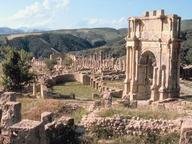Quiz Answer Key and Fun Facts
1. Annaba is one of the largest cities in Algeria and is known for its beaches that lie on the coast of the Mediterranean Sea. It is a short distance from the ruins of a city that was home to a 4th and 5th century bishop, whose writings had a significant impact on the future of Christianity. An important location in Roman times, what was the ancient name of this city?
2. Amongst the Algerian sites that UNESCO has thought worthy of adding to its World Heritage list is a Saharan mountain range that can be found in the south-east of Algeria. There you can find some fine examples of prehistoric art amongst a beautiful setting. What is the name of this World Heritage Site?
3. Timgad was a Roman colonial town that rose up at the close of the 1st century A.D. Its ruins are particularly noted as an excellent example of Roman town planning, and you can see the two perpendicular roads, the cardo and decumanus, running through the town. Other pieces of architecture that are particularly striking are an impressive theatre and triumphal arch. With which name is the triumphal arch associated?
4. The Al Qal'a of Beni Hammad was the capital of the Hammadid empire in the 11th century. It is notable for its ruins in a beautiful, mountainous setting, and its importance has been noted by UNESCO who includes it on their World Heritage list. The evidence of which of the following types of building will you find at the site?
5. Madaure was an ancient settlement that as well as coming under Roman rule, had previously been under control of the Punic era kingdoms of Syphax and Massinissa. It was particularly renowned for its educational establishments, and was the home of the famous Berber writer Apuleius. Which picaresque novel, the only Latin novel to still exist in its entirety, did Apuleius write?
6. In the 2nd century B.C., Rome was involved in the Jugurthine War. Jugurtha was the king of Numidia and after capturing the city of Cirta from his brother Adherbal, he was responsible for massacring the Italian population that were resident there. This didn't go down too well with the Romans, and led to them increasing their military presence in Numidia, all in a bid to bring Jugurtha to his knees. What is the name of the modern day city that is built on the ruins of Cirta?
7. The M'Zab Valley is situated in the northern Sahara and has been the residence of Berber tribes for centuries. Of particular note are five fortified villages that are fine examples of architecture perfectly adapted towards their environment. Which word can be used to describe such a Berber village, which can also be found at various other sites in the Maghreb?
8. Tipasa is a town with a nice sandy beach beautifully situated on the coast of the Mediterranean Sea, around 50km west of Algiers. It is perhaps most famous for its extensive Roman ruins, which have been deemed so significant that Tipasa was one of Algeria's first entries on the World Heritage List in 1982. In 2002, it was decided to add Tipasa to UNESCO's List of World Heritage Sites in Danger. Which of these was NOT a reason given as to why this was deemed necessary?
9. Béjaïa has been subjected to many different types of rule over the centuries. It acted as the capital of the Vandals in the 5th century, and was known as Bougie is French colonial times. Perhaps the most famous person associated with the city is a mathematician. He is particularly known for his famous sequence, which may be familiar to those that have read "The Da Vinci Code". Who was he?
10. One of the most impressive sets of Roman remains in Algeria can be found at a mountain village near the Mediterranean coast. Particularly impressive are the remains of the theatre, and it has been recognised by UNESCO as an "interesting example of Roman town planning adapted to a mountain location". Which World Heritage Site is this?
Source: Author
ajwtimperley
This quiz was reviewed by FunTrivia editor
Pagiedamon before going online.
Any errors found in FunTrivia content are routinely corrected through our feedback system.
